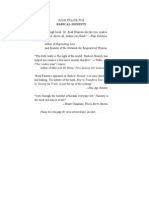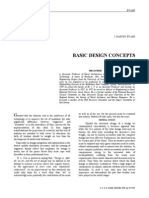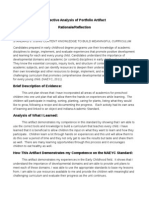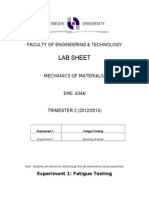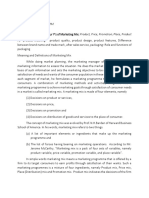Industrial 20 Design 20 Brief 1
Industrial 20 Design 20 Brief 1
Uploaded by
api-265616652Copyright:
Available Formats
Industrial 20 Design 20 Brief 1
Industrial 20 Design 20 Brief 1
Uploaded by
api-265616652Original Title
Copyright
Available Formats
Share this document
Did you find this document useful?
Is this content inappropriate?
Copyright:
Available Formats
Industrial 20 Design 20 Brief 1
Industrial 20 Design 20 Brief 1
Uploaded by
api-265616652Copyright:
Available Formats
INDUSTRIAL DESIGN BRIEF
The Problem and Design Brief are sometimes vieed as to different se!tions of the design "ro!ess#
$oever% the& are ver& !losel& related# Before &o' !an !an start a design "ro(e!t &o' m'st find a
)"roblem* to solve#
The )design brief* follos the )"roblem* and states !learl& ho &o' intend to solve the design "roblem#
The brief and "roblem shon belo has been "rod'!ed for a "ro(e!t based on an ed'!ational to&#
T$E DESIGN PR+BLE,
1. The brief and "roblem is mainl& te-t .riting/ that is "rinted in a !lear st&le so that it !an be read and
'nderstood easil&#
2. The "roblem is a "aragra"h or more in length# It des!ribes the "roblem &o' are aiming to solve# Do not
sa& ho &o' intend to solve the "roblem% onl& hat the "roblem is# If &o' have been given a e-amination
0'estion as &o'r design "ro(e!t% add more detail# The e-am"le o""osite is based on the folloing
e-amination 0'estion1
2Design and ma3e an ed'!ational devi!e for &o'ng !hildren# It m'st im"rove hand and e&e !oordination4#
The "roblem ritten o""osite is a more detailed and imaginative a& of riting the e-amination
0'estion# A "edestrian !rossing sim'lator has been sele!ted b& the "'"il as the ed'!ational devi!e#
3. The first senten!e sho'ld state the "roblem% adding more detail ith the folloing senten!es#
4. If the e-amination 0'estion does not name the "rod'!t that has to be designed and made .s'!h as an
ed'!ational devi!e/ 5 &o' !an mention an area that &o' are interested in# This !o'ld in!l'de% (igsas%
"'66les or something that !o'ld be ada"ted as an ed'!ational devi!e#
T$E DESIGN BRIEF
1. Ala&s start the design brief ith 2I am going to design and ma3e #####4# This is folloed b& a general
des!ri"tion of the t&"e of devi!e &o' feel ill anser the design "roblem#
2. Do not be too s"e!ifi!# The brief sho'ld be a general des!ri"tion that allos &o' fle-ibilit& regarding
the t&"e of "rod'!t &o' intend to ma3e# For e-am"le% if &o'r are designing an a'tomati! animal feeder it
ma& be a good idea not to sa& the t&"e of animal it is for% at least not at this stage in the "ro(e!t#
3. Do not be s"e!ifi! abo't materials# It ma& be ise to avoid stating the e-a!t materials it ill be
man'fa!t'red from .eg# "ine% steel% "ers"e- et!###/# Instead des!ribe the materials to be 'sed as strong%
to'gh% fle-ible% nat'ral% manmade% re!&!led% ater5"roof or similar general des!ri"tions#
4. ,ention "oints s'!h as7 safet&% general si6e% hat it ill do .it*s f'n!tions/% general "ro"erties of the
materials needed% ho it is for .eg !hildren/% basi! !ost of man'fa!t're or a loer and '""er !ost limits%
!ir!'it re0'irements and other "oints &o' feel are im"ortant#
FINDING A DESIGN PR+BLE, T+ S+L8E 5 SUGGESTI+NS1
A. Is there a "rod'!t that &o' !o'ld im"rove for a hobb& or interest9
B. Is there an item that &o' 'se ever& da& that !o'ld be im"roved9 Is there an item that !o'ld be ada"ted
for disabled "eo"le or &o'ng !hildren or the elderl&9 or another gro'" of "eo"le9
C. As3 &o'r friends and relatives# The& ma& have a fe s'ggestions abo't design "roblems &o' !an solve
that ill hel" them#
D. Do not be over ambitio's# Do not sele!t a design "roblem that is too !om"le-#
E. As3 the tea!her for advi!e and loo3 at !om"leted "ro(e!ts for ins"iration#
F. :om"lete &o'r homeor3 on time# Do not fall behind as &o' ma& find it im"ossible to !at!h '"#
To b'ild a !'stomer "rofile &o' !o'ld as3 a fo!'s gro'" some of the 0'estions
listed belo and !arr& o't 0'estionnaires# Alternatel& &o' !o'ld as3 &o'rself or
"eo"le in &o'r !om"an&;!lass the same 0'estions#
<# Des!ribe the t&"e of "erson ho !o'ld be &o'r t&"i!al !'stomer .or ill be &o'r
t&"i!al !'stomer/#
=# >hat is the age range of "otential !'stomers9
?# Are "otential !'stomers li3el& to be male or female or does gender matter9
@# >hat is the geogra"hi!al lo!ation of "otential !'stomers9 >here are the& li3el&
to live9
A# >hat are the most li3el& o!!'"ations of "otential !'stomers9
B# >hat are the general li3es ;disli3es of "otential !'stomers9
C# >hat does a t&"i!al !'stomer ant from the "rod'!t &o' design and
man'fa!t're9
D# >hat ma3es &o'r "rod'!t more s'itable to "otential !'stomers than that of &o'r
!om"etitors9
E# >hat are the most !ommon design re0'irements shared b& &o'r "otential
!'stomers9
<F# >hat fa!tors are &o'r "otential !'stomers li3el& to !onsider before "'r!hasing
&o'r "rod'!t9
<<# >hat do &o'r !'stomers val'e from &o'r !om"an&% "rod'!ts or servi!es9
<=# $o ill "otential !'stomer find o't abo't the "rod'!t &o' are selling9
<?# >hat have "revio's !'stomers said abo't &o'r !om"an& ; "rod'!t9
<@# Does the !ost of &o'r "rod'!t infl'en!e a !'stomers de!ision to b'& from &o'9
<A# List all the a&s in hi!h !onta!t !an be made ith &o'r "otential !'stomers#
Go' ma& in!l'de the folloing "oints1
Sales Team
>ebsite
Point of Sale
S'rve&s
:omm'ni!ations
Distrib'tion De"artment
Resear!h H Develo"ment
,ar3eting Literat're 5 thro'gh the "ost#
Dire!t ,ail
E-hibitions
Advertising 5 T8% Radio% Internet% ,aga6ines% Nes"a"ers% Billboards et!####
>hen &o' have !reated a !'stomer "rofile &o' ill be able to fo!'s all &o'r efforts
on "otential !'stomers# This ill hel" &o' "romote ; advertise &o'r "rod'!t dire!tl&
to those most li3el& to b'&#
+PP+RTUNITG Problem
,ar3et I target
,ar3et I !om"etition
:'stomer "rofile
Pla!e of 'se
PR+P+SED PR+DU:T Prod'!t vision
F'n!tionalit& des!ri"tion
:onstraints
Ass'm"tions
Ergonomi! iss'es
Aestheti! iss'es
Te!hni!al iss'es
PR+JE:T +b(e!tive
Pro(e!t goals
B'siness goals
Prod'!tion vol'mes
B'dget
Ris3s
S"e!ifi! re0'irements
:AD !om"atibilit&
Pro(e!t management
S'!!ess !riteria
:+,PANG Ba!3gro'nd information
B'siness strateg&
INDUSTRIAL DESIGNER
REKUIRE,ENTS
S!o"e of involvement
S3ills re0'ired
Terms of b'siness
from www.vrc.gr:8080/npd-net/files/document/npd/Industrial%20Design%20Brief.doc
PR+JE:T STAGE
.:LI:L BEL+>/
DES:RIPTI+N +F STAGE TI:L
>$EN
:+,PLETE
WORD SPLASH
At the beginning of the "ro(e!t "la!e the theme at the !entre# P't ords ;
themes that are !onne!ted to it% aro'nd it#
DESIGN PROBLEM
AND DESIGN BRIEF
State the design "roblem !learl&# E-"lain ho &o' intend to solve it in
general terms#
Anser the folloing 0'estions1
CUSTOMER
PROFILE
Develo"ing a :'stomer Profile 5 "age< 5 >ho are &o'r "otential
!'stomers9 :arr& o't a :'stomer Profile K'estionnaire# Go' need to
b'ild a Potential :'stomer Profile# Then "rod'!e a final
:lient;:'stomer Profile Sheet% on!e &o' have been !ommissioned to
design and ma3e a "rod'!t#
ANALYSIS
List as man& 0'estions as &o' !an abo't the "ro(e!t &o' are attem"ting#
E#g# >hat materials !an I 'se 9
>hat safet& !onsiderations m'st I 3ee" in mind 9
SYNTHESIS Anser the 0'estions in the anal&sis#
PLANNING
Use a time !hart and flo !hart to "lan &o'r 'se of time# .See additional
sheet/
RESEARCH
If &o' are to get a high grade &o' m'st "'t effort into this se!tion#
Remember% all resear!h m'st be relevant to &o'r "ro(e!t and !onstantl&
refer to the "roblem &o' are tr&ing to solve# Prod'!e at least one sheet
on ea!h of the folloing1
S'itable materials for &o'r "ro(e!t#
Investigate the a&s in hi!h materials !an be (oined together 5 (oints
and fi-ings#
The ergonomi! fa!tors that a""l& to &o'r "ro(e!t#
Safet& fa!tors related to &o'r design "roblem#
>rite letters to man'fa!t'rers ; sho"s#
Resear!h 'sing the librar&#
Resear!h 'sing the Internet ; :D5R+,s;D8Ds#
Intervie "eo"le ith the aim of hel"ing &o' to solve the design
"roblem .re!ord the intervie/#
:arr& o't a s'rve& ; 0'estionnaire and "resent the res'lts as a
"i!togram;table of res'lts#
Prod'!t Revie 5 sele!t an e-isting "rod'!t and determine ho it !o'ld
be im"roved# This ill hel" &o' develo" &o'r on ideas later#
:olle!t "i!t'res of e-isting "rod'!ts 5 "hotogra"hs;!atalog'e "i!t'res#
$o are e-isting "rod'!ts man'fa!t'red9
Resear!h other relevant areas s'!h as ele!troni! !ir!'its#
SPECIFICATION
+n!e &o' have !om"leted &o'r design &o' sho'ld s"e!if& in a "aragra"h
or to hat e-a!tl& &o' are going to do to solve this "roblem# Ala&s
refer to &o'r resear!h#
IDEAS
Dra at least si- ideas% ith notes# The ideas sho'ld be different and not
('st the same idea slightl& !hanged# In!l'de environmental
!onsiderations .See additional sheet/
DEVELOPMENT
To get the higher grades &o' m'st ta3e &o'r best idea and develo" it
f'rther# +ne a& of starting this se!tion is to dra &o'r best idea again
and "oint o't areas that !an be im"roved# Areas ma& in!l'de% safet&%
!olo'r s!heme% !ost% 'sing a s"readsheet% sha"e% materials% me!hanisms%
!ir!'its% s&stems diagram and the environment# Go' m'st sho that &o'
have !onsidered Safet& and the :ons'mer# Go' also need to develo" a
!ir!'it for &o'r "ro(e!t# Go' ma& need to sho ho me!hanisms !an be
'sed as "art of &o'r design# $o ill all the "arts;!om"onents be (oined
together9 >hat (oints and fi-ings ill be needed9 Stages of
"rogramming a mi!ro!ontroller !ir!'it .flo !hart/# ,a3e a series of
models and eval'ate ea!h one# :arr& o't a Prod'!t :om"arison to hel"
develo" a design# :li!3 here for Prod'!t :om"arison la&o't sheet and
tem"lates# In!l'de a Te!hni!al Data Sheet in &o'r design "ro(e!t 5
Te!hni!al Data Sheet Tem"late# As3 a Fo!'s Gro'" .gro'" of
individ'als/ their advi!e regarding &o'r designs and models#
SOLUTION
Prod'!e a or3ing draing of &o'r sol'tion ith a "arts list# This m'st
have meas'rements and !onstr'!tional details# Go' ma& "refer to
"rod'!e a Parts Sheet first# A three dimensional draing !an also be
attem"ted#
MANUFACTURE
Prod'!e "lanning sheets to sho ea!h stage of "rod'!tion 5 a flo!hart%
time !hart% se0'en!e draing#
,a3e a f'rther model#
,a3e the sol'tion# Lee" a Logboo3 '" to date
EVALUATION
Do not forget this im"ortant se!tion# Eval'ate &o'r "rod'!t# State the
good and bad "oints# Does the sol'tion anser the design brief 9 S"end
some time on this se!tion# Go' sho'ld in!l'de so!ial iss'es% health and
safet&% ethi!al and environmental iss'es#
Elements of Aesthetics
There are many different things that contribute to your overall perception of a product, and
to your opinion as to whether it is aesthetically pleasing to you.
Vision Hearing Touch Taste Smell
Colour
Shape
Pattern
Line
Texture
Visual weight
alance
Scale
!ovement
Loudness
Pitch
eat
"epetition
!elody
Pattern
#oise
Texture
Shape
$eight
%ive
Comfort
Temperature
Vibration
Sharpness
&ase of use
Strength
Sweetness
Sourness
Texture
Strength
Sweetness
'Pleasantness'
(our opinion about a product may also be influenced by certain associations that are
important to you, such as)
how fashionable it is
whether it is a novelty, or an old favourite
whether it is a symbol of wealth or love
how much danger or ris* is involved
if it provides a lin* with your past
(ou might also ta*e into account whether it is safe and reliable and fit for its purpose.
Consistency with a particular aesthetic concept
may be a significant factor in creating a
product's appeal too, for example, the current
appreciation of 'retro' designs.
+owever, such trends are often cultural and
almost certainly always short,lived, so their
popularity can't be guaranteed.
Consideration of aesthetics in design
There are four different 'pleasure types' to consider)
Physio-pleasure , pleasure derived from the senses from touch, smell,
sensual pleasure etc. -or example the smoothness of a curve in a hand,
held product or the smell of a new car.
Socio-pleasure , pleasure gained from interaction with others. This may
be a 'tal*ing point' product li*e a special ornament or painting, or the
product may be the focus of a social gathering such as a vending machine
or coffee machine. This pleasure can also come from a product that
represents a social grouping, for example, a particular style of clothing that
gives you a social identity.
Psycho-pleasure , pleasure from the satisfaction felt when a tas* is
successfully completed. Pleasure also comes from the extent to which the
product ma*es the tas* more pleasurable, such as the interface of an .T!
cash machine, that is /uic* and simple to use. 0t is closely related to
product usability.
Ideo-pleasure , pleasure derived from entities such as boo*s, art and
music. This is the most abstract pleasure. 0n terms of products, it is the
values that a product embodies, such as a product that is made of eco,
friendly materials, and processes that convey a sense of environmental
responsibility to the user.
&ach of these pleasures should be considered in turn , their importance to the product you are
designing, and how each aspect might show itself in that product.
adapted by Patrick Jordan from the work of sociologist Lionel Tiger
Aesthetics and ergonomics in product design
M,ore and more "eo"le b'& ob(e!ts for
intelle!t'al and s"irit'al no'rishment#
Peo"le do not b'& m& !offee ma3ers%
3ettles and lemon s0'ee6ers be!a'se the&
need to ma3e !offee% to boil ater% or to
s0'ee6e lemons% b't for other reasons#M
Alberto Alessi, Designer
This /uote gives an indication of how the world of product design has changed over the past
few decades. .n appreciation of pleasure in product use is fast becoming of primary
importance to both consumer and the design industry ali*e. Consumers' expectations have
been raised1 they no longer simply expect the products they buy to be functional and usable.
Consumers demand functionality, expect usability and are see*ing products that that elicit
other feelings such as pleasure or that stri*e a certain emotional chord. 0t li*ely to be the
aesthetics of the product1 the way it loo*s, the feel of the material, the tactile or 'haptic'
response of controls or more abstract feelings, such as reflected status, that give pleasure.
Traditionally, product design has been considered to comprise three main elements)
Product 2esigners need a *nowledge of all these elements. 0n the case of the design of a
small or simple product, the designer's responsibility may be for all of these elements. 0n the
case of larger products, such as cars, the designer's responsibility may be for aesthetics only1
ergonomists and engineers providing the expertise needed for the other elements.
Conventionally, ergonomics has consisted of usability and functionality, and designing
pleasure into the product has been the 3ob of the designer. +owever, increasingly the
boundaries between the two disciplines are disappearing, and ergonomists are ta*ing some
responsibility for the aesthetics of the design, using scientific methods to increase
understanding of the aesthetics 4both pleasurable and displeasurable5 and applying this to the
design of products.
The best design occurs when all three components are considered together from the start of
the design process. 6sually, compromises will have to be made, but understanding all the
issues involved will help to ma*e the most acceptable compromises. -or example, if you are
designing a sports car, you will ma*e different compromises from those that you will ma*e if
you are designing a family saloon car.
Sports car
The emphasis is on aesthetics and performance. The car may go
very fast, loo* beautiful and ma*e all the right sort of noises.
+owever, it is li*ely to be difficult to get in and out of, have little
storage space, seat only two people and have limited visibility.
The physical and functional ergonomics are not the best but the
car is exactly what the consumer is expecting of a sports car.
&rgonomics is compromised in order to achieve performance and aesthetics.
Family saloon car
The emphasis is on functionality and usability. The car should
first serve the needs of the family, so will have ade/uate seating
and storage space and be suitable for family travelling. 0t should
also have aesthetic appeal but there may be compromises in
design in order to provide the re/uired levels of functionality and
usability.
Woring !ith aesthetics and ergonomics
Compromises need to be made in different ways depending
upon the product.
Where ergonomics and aesthetics meet
Clearly, many aesthetic ideas are easily combined with good
ergonomics, for example, chairs that loo* good and are
comfortable too1 buttons on your mobile phone that give good
feedbac*. This .lessi cor*screw has obviously been designed to
be more than 3ust a cor*screw, but it is extremely functional as
well.
Where aesthetics may predominate
There are other products that conflict directly with ergonomics
principles. -or example, cars that go so fast they thrill you
despite 4or is it because of75 the ris* that you are ta*ing.
+owever, whilst speed limits and traffic calming measures exist
to slow fast cars down in dangerous situations, these fast,
thrilling ob3ects of desire are still designed and manufactured.
.nother example of aesthetics having more influence than
ergonomics is shoes that are beautiful and very fashionable,
but are bad for your feet and your posture, and increase the
ris* of slipping and hurting yourself. $e are all educated as
small children about the need to wear well,fitting, flat shoes for
healthy feet, but we would complain if all footwear had to be
designed by ergonomic principles only.
Where aesthetics must ne"er predominate
Conversely, there are situations where ergonomics principles
must override aesthetics, such as products that are used in
safety,critical situations. -or example, e/uipment designed for
use in operating theatres or by air traffic controllers. There is
much legislation concerning the safety of products and
designers must wor* within these constraints of legislation or
their products will not be allowed to enter the mar*et place. -or
more on product safety, see the product evaluation topic.
Where to compromise
!any products are not safety,critical and the designer must
ta*e the responsibility for balancing aesthetics and ergonomics
appropriately. !iniaturisation of products is an example worth
considering. $hen mobile telephones were first designed,
technology dictated that they were the si8e of a small
housebric*9 The displays and controls were easily usable by
most people, but they considered the phones to be too large
and heavy to be very 'mobile'. Technological advances allowed
the production of smaller phones and they became truly
'mobile'1 fitting easily into handbags and poc*ets. +owever, the
control and display si8es were compromised and many have
become too small for easy use. The optimum compromise was
not recognised.
You might also like
- Brad Blanton Radical HonestyDocument309 pagesBrad Blanton Radical HonestyUda Lapau67% (3)
- Product Design, Fundamentals and Methods PDFDocument7 pagesProduct Design, Fundamentals and Methods PDFis03lcm0% (10)
- Brad Blanton - Radical HonestyDocument312 pagesBrad Blanton - Radical Honestycontrarian_is_me80% (15)
- J. Harvey Evans - Basic Design ConceptsDocument8 pagesJ. Harvey Evans - Basic Design Conceptsnf_azevedo100% (1)
- Bar EquipmentDocument10 pagesBar EquipmentCindy Ortiz Gaston100% (2)
- ABAP in BI 1.0Document15 pagesABAP in BI 1.0Saravana KumarNo ratings yet
- Bases Del Diseño Del Producto MaterialesDocument186 pagesBases Del Diseño Del Producto MaterialesSold Dexter100% (1)
- Delphi Method2Document8 pagesDelphi Method2Katrina AgpoonNo ratings yet
- Abhishek KumarDocument3 pagesAbhishek KumarManpreet SachdevaNo ratings yet
- Saurabh Jain ResumeDocument5 pagesSaurabh Jain ResumeSaurabh JainNo ratings yet
- CHAPTER 3 (Proofreading)Document20 pagesCHAPTER 3 (Proofreading)Nazirul Mubin Mohd NoorNo ratings yet
- Dos and Dont's For Indie AuthorsDocument17 pagesDos and Dont's For Indie AuthorsHelicon1No ratings yet
- Career Research Guide Worksheet2013Document2 pagesCareer Research Guide Worksheet2013api-254126096No ratings yet
- Rationale Reflection Standard 5Document1 pageRationale Reflection Standard 5api-250781965No ratings yet
- LEGWRI - Memo - K 12 Basic EducationDocument3 pagesLEGWRI - Memo - K 12 Basic EducationLilybeth PetalloNo ratings yet
- Enlarge A4 Copies Write Your Own - Ee-Poem' See Below: Page 2 of 2Document24 pagesEnlarge A4 Copies Write Your Own - Ee-Poem' See Below: Page 2 of 2FhaAzmiNo ratings yet
- Folio Chemistry Chapter 9Document23 pagesFolio Chemistry Chapter 9Justin HardinNo ratings yet
- La9 Regular Open Disclosure 13-14Document5 pagesLa9 Regular Open Disclosure 13-14api-243080555No ratings yet
- Graphic Design Final WhiteDocument8 pagesGraphic Design Final Whiteawhite130No ratings yet
- IELTS Writing Task 2Document65 pagesIELTS Writing Task 2Nariman Gahramanli100% (1)
- Metrics IntangiblesDocument17 pagesMetrics IntangiblesK Srinivasa RaoNo ratings yet
- Programaaula Twister 6 2009 LoeDocument117 pagesProgramaaula Twister 6 2009 LoeZouBisouBisouNo ratings yet
- Term Paper OF Cell Biology: Lovely Professional UniversityDocument15 pagesTerm Paper OF Cell Biology: Lovely Professional UniversityMedina Fadlilatus SyaadahNo ratings yet
- Graphic Design: There's More Than What Meets The Eye: White 1Document8 pagesGraphic Design: There's More Than What Meets The Eye: White 1awhite130No ratings yet
- Evidence: Agreeing and Disagreeing Politely With Reasons InstructionsDocument2 pagesEvidence: Agreeing and Disagreeing Politely With Reasons InstructionsZahariah Mohd ZainNo ratings yet
- Reading Enrichment UnitDocument2 pagesReading Enrichment Unitmr03557No ratings yet
- Job Interviews English CourseDocument11 pagesJob Interviews English CourseAlexandra Mihai100% (1)
- Case Study On: Aditya Institute of Post Graduate StudiesDocument41 pagesCase Study On: Aditya Institute of Post Graduate StudiesLegend EfsaneNo ratings yet
- Writing Exam Uneb Avancado 3 091213Document6 pagesWriting Exam Uneb Avancado 3 091213Hélio PereiraNo ratings yet
- Sensitivity Test of Interest Rate SwapsDocument7 pagesSensitivity Test of Interest Rate SwapsHafizur Rahman DhruboNo ratings yet
- ObservationnotesDocument3 pagesObservationnotesapi-238510276No ratings yet
- Employees Perform The Same Tasks As Before in A Shorter Time. So The Company Is NotDocument2 pagesEmployees Perform The Same Tasks As Before in A Shorter Time. So The Company Is Notlakmus6No ratings yet
- Silabus: Sekolah: SMP........... Kelas: VIII (Delapan) Mata Pelajaran: Bahasa Inggris Semester: 1 (Satu)Document25 pagesSilabus: Sekolah: SMP........... Kelas: VIII (Delapan) Mata Pelajaran: Bahasa Inggris Semester: 1 (Satu)Andi SudihartoNo ratings yet
- Grant ProposalDocument6 pagesGrant ProposalRyan OGradyNo ratings yet
- Project RubricDocument2 pagesProject Rubricapi-248398775No ratings yet
- Lab Sheet: Faculty of Engineering & TechnologyDocument13 pagesLab Sheet: Faculty of Engineering & TechnologyWae'l MohamedNo ratings yet
- De MarketingDocument14 pagesDe MarketingAnonymous xpdTqvNo ratings yet
- الدليل العملي للمترجمين PDFDocument95 pagesالدليل العملي للمترجمين PDFMohammad A YousefNo ratings yet
- An Introduction To OOPS Concepts With HandsDocument23 pagesAn Introduction To OOPS Concepts With HandsrabiabaseeraNo ratings yet
- Essay Writing: PLAGIARISM And/or Lack of Proper Referencing Will NOT Be ToleratedDocument2 pagesEssay Writing: PLAGIARISM And/or Lack of Proper Referencing Will NOT Be ToleratedAlinaNo ratings yet
- SDCVSDBVHBVHJFDDocument2 pagesSDCVSDBVHBVHJFDapi-251906424No ratings yet
- Unit 7 Ac Voc All WordDocument2 pagesUnit 7 Ac Voc All Wordapi-235883531No ratings yet
- Evolution of The BIM Process and Involvement in Sustainable Design and ConstructionDocument8 pagesEvolution of The BIM Process and Involvement in Sustainable Design and ConstructionCayo CostaNo ratings yet
- Project Overview: Duration: Grade LevelDocument2 pagesProject Overview: Duration: Grade Levelsheridan9311No ratings yet
- Goodrich 1997 Understanding RubricsDocument4 pagesGoodrich 1997 Understanding RubricsBahrouniNo ratings yet
- Fine Institute: Architecture Design VDocument8 pagesFine Institute: Architecture Design VamritagcadNo ratings yet
- Water Color Ice Cube PaintingDocument1 pageWater Color Ice Cube Paintingapi-252663460No ratings yet
- Sol 3.7 - Sol 3.8 - Sol 3.9 - Sol 3.10Document19 pagesSol 3.7 - Sol 3.8 - Sol 3.9 - Sol 3.10Judz SawadjaanNo ratings yet
- Merkaba Meditation According Drunvalo MelchizedekDocument16 pagesMerkaba Meditation According Drunvalo MelchizedekAlejandra GonzalezNo ratings yet
- "Employer Branding: Conceptualization in Indian Context": AbstractDocument13 pages"Employer Branding: Conceptualization in Indian Context": AbstractManvi JainNo ratings yet
- Approach To The Difficult Airway: Textbook ReadingDocument13 pagesApproach To The Difficult Airway: Textbook Readingbudimulyawan23No ratings yet
- Notes On They Say / I Say:: The Moves That Matter in Academic WritingDocument12 pagesNotes On They Say / I Say:: The Moves That Matter in Academic WritingunfreknblvableNo ratings yet
- LESSON 01 - Stative Verbs and Collocation. Sociology-The Study of Human Society WolfeDocument5 pagesLESSON 01 - Stative Verbs and Collocation. Sociology-The Study of Human Society WolfeMadalina TicuNo ratings yet
- Toyota Marketing PlanDocument19 pagesToyota Marketing PlanClaudiu DraganNo ratings yet
- MentalismDocument43 pagesMentalismPedro Curvinha91% (11)
- 2 Logistics InformationDocument5 pages2 Logistics InformationTejaswini KotianNo ratings yet
- LET TOS Prof EdDocument10 pagesLET TOS Prof EdNorman SernaNo ratings yet
- v-Myb proteins and their oncogenic potential: A study on how two point mutations affect the interaction of v-Myb with other proteinsFrom Everandv-Myb proteins and their oncogenic potential: A study on how two point mutations affect the interaction of v-Myb with other proteinsNo ratings yet
- The Global Player: How to become "the logistics company for the world"From EverandThe Global Player: How to become "the logistics company for the world"No ratings yet
- Computer Programming: A Simplified Entry to Python, Java, and C++ Programming for BeginnersFrom EverandComputer Programming: A Simplified Entry to Python, Java, and C++ Programming for BeginnersNo ratings yet
- Iv Mech Rec - PPC - U1Document20 pagesIv Mech Rec - PPC - U1gayatriNo ratings yet
- ME4000 F2009 Lect2 Overview Introduction To DesignDocument7 pagesME4000 F2009 Lect2 Overview Introduction To Designlenghiemckt07No ratings yet
- PPT1 Plastics Product DesignDocument7 pagesPPT1 Plastics Product DesignLalitya KrishnanNo ratings yet
- Future of Product DesignDocument29 pagesFuture of Product DesignJorge Miranda100% (2)
- Captura de Tela 2023-10-04 À(s) 12.51.23Document12 pagesCaptura de Tela 2023-10-04 À(s) 12.51.23douglasharmonia25No ratings yet
- Operations Management 2nd Sem Mba at Bec DomsDocument164 pagesOperations Management 2nd Sem Mba at Bec DomsBabasab Patil (Karrisatte)No ratings yet
- Figure 8.1: Production SystemDocument4 pagesFigure 8.1: Production SystemHaseeb KhalidNo ratings yet
- Peter Lunt: Product Design PortfolioDocument12 pagesPeter Lunt: Product Design Portfoliopeter luntNo ratings yet
- Concept GenerationDocument4 pagesConcept GenerationShahir Afif IslamNo ratings yet
- Module 1 & Module 2 - Beginner's Level Course DetailsDocument7 pagesModule 1 & Module 2 - Beginner's Level Course Detailsmeiyyammai.sproutNo ratings yet
- Integrating Environmental Aspects To DesignDocument4 pagesIntegrating Environmental Aspects To Designapi-3701058No ratings yet
- Toys and The Design ProcessDocument1 pageToys and The Design ProcessaravinthNo ratings yet
- COURSE 1003 - Jr. Product Designer and Developer-GenericDocument13 pagesCOURSE 1003 - Jr. Product Designer and Developer-GenericOmkar KoreNo ratings yet
- Using Physical Models in DesignDocument9 pagesUsing Physical Models in DesignHatem HadiaNo ratings yet
- Marketing Mix 11Document22 pagesMarketing Mix 11Leofold Laluna Salas Jr.No ratings yet
- Design of Production SystemDocument31 pagesDesign of Production SystemaireencloresNo ratings yet
- 1.what Are The Characteristics of Good Product Design?Document5 pages1.what Are The Characteristics of Good Product Design?Breev AldenNo ratings yet
- Acknowledgement: Cobblestone Shaping MachineDocument92 pagesAcknowledgement: Cobblestone Shaping MachineFikru GebreNo ratings yet
- Product and Service DesignDocument46 pagesProduct and Service DesignKim TaengoossNo ratings yet
- POM Unit 1Document16 pagesPOM Unit 1Sandeep ShrivastavaNo ratings yet
- Ace BrainDocument2 pagesAce BrainKrupal PatelNo ratings yet
- IPE 3109: Product Design-IDocument31 pagesIPE 3109: Product Design-IZahidul IslamNo ratings yet
- Product Design: From Wikipedia, The Free EncyclopediaDocument3 pagesProduct Design: From Wikipedia, The Free EncyclopediaabhaybittuNo ratings yet
- Detailed Drawing Exercises: Solidworks EducationDocument51 pagesDetailed Drawing Exercises: Solidworks EducationVedad HodžićNo ratings yet
- ISDI BrochureDocument18 pagesISDI BrochureSaumil BhandariNo ratings yet
- Product Design: Build A Base-Case Financial Model Sensitivity Analysis To Understand Project Trade-OffsDocument26 pagesProduct Design: Build A Base-Case Financial Model Sensitivity Analysis To Understand Project Trade-OffsPradeep ShanmukhaNo ratings yet
- Chapter 1: Operations and ProductivityDocument10 pagesChapter 1: Operations and ProductivityMel De VeraNo ratings yet
- Karjala in enDocument13 pagesKarjala in enDesica AdimiaNo ratings yet


